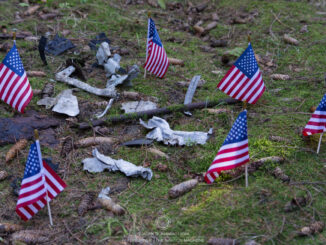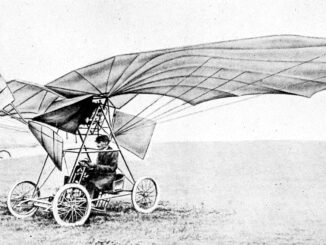 On 30th August 1914, only a month after the outbreak of the Great War, a single German Taube aircraft performed an air raid on the French capital, dropping a few bombs and a bag of leaflets.
On 30th August 1914, only a month after the outbreak of the Great War, a single German Taube aircraft performed an air raid on the French capital, dropping a few bombs and a bag of leaflets.
The German aviators that performed the first aerial attack on Paris were Lieutenant Ferdinand von Hiddessen and his observer, name unknown. The German crew took-off from the St. Quentin area with the Taube aircraft and reached Paris about noon of 30th August.
According to some reports, the German aircraft circled over the French capital for approximately thirty minutes before the first bombs were dropped. However, it would mean von Hiddessen pushed his aircraft to its limits which was kind of unnecessarily risk. The flight endurance of Taube aircraft was not exceeding four hours, while just the flight from St. Quentin to Paris and back meant more than two and a half hours in the air. And every further minute increased the possibility the aircraft engine could break down suddenly on their way back.
There is a lot of uncertainty regarding effects of the von Hiddessen´s air raid. There are various versions of the story existing and they vary in number of bombs the Taube was carrying on board (from two to five), locations the bombs were dropped (Quai de Valmy is the sole confirmed location) and number of casualties (from none to two – or even more – dead and couple of injured persons). There is also a common story telling the Taube crew dropped on Paris not only the official load of bombs and leaflets, but also a pendant saying the Germans are at the gates of Paris and the only option is to surrender.
It may be said with high probability that at least one building at Quai de Valmy was damaged, with one person killed there. The leaflets dropped on Paris had no effect whatsoever, as the German crew did not untie the bag and it was found in the street and secured by the authorities.
The French war propaganda used the air raid to turn the heat up and set the tone for supporting the war effort. The press reported the Germans used aeroplanes to sow terror on a peaceful city and dropped bombs on hospitals. In fact, the building at Quai de Valmy was an elderly shelter but saying about any precision bombing that time was just an exaggeration.
In addition, the French press calmed down the public opinion that German aeroplanes were almost immediately intercepted by numerous French aircraft and destroyed. And that was another propaganda tool, as no one disturbed von Hiddessen during the flight. Neither fighter aircraft nor air defence existed in August of 1914.

The reason why German military authorities have chosen von Hiddessen for that pioneering air raid was simple. He was not only an experienced aviator but also winner of several aviation competitions, including endurance flights. Before the war, Ferdinand von Hiddessen was also the first to fly with an air mail in Rhine-Main region, as well as the first to perform meteorological flights in Germany.
During the air raid on Paris, von Hiddessen made a few more ´firsts´ in the aviation history. It was the first aerial operation against the civilian target and the first – although inefficient – drop of leaflets on enemy city from heavier-than-air aircraft. In addition, von Hiddessen and his observer made an effective aerial reconnaissance of Paris, defining possible targets for future air raids. The first of them was performed already in two weeks, on 13th October 1914, when two German Taubes bombed the French capital again.
In 1915, Ferdinand von Hiddessen was shot down over Verdun, wounded and captured by French troops. After returning from war captivity, he retired from the air force and became a farmer in the Lower Silesia region.
Yet in 1929, von Hiddessen joined the NSDAP and later was member of the German parliament. In 1933, he was appointed the police president in Waldenburg (now Wałbrzych, Poland) and joined Sturmabteilung – SA, the paramilitary wing of the Nazi Party.
In 1937, the NSDAP founded its paramilitary aviation organization, named Nationalsozialistisches Fliegerkorps (the National Socialist Flyers Corps – NSFK). Ferdinand von Hiddessen was appointed the leader of NSFK Standarte Waldenburg and in May of 1939 was transferred to Karlsruhe. In 1940, he joined the Luftwaffe in the rank of captain. Von Hiddessen spent the following years of the World War II in the southwestern Germany, taking care of the NSFK activities there.
After the war, he settled in the Black Forest area and continued with farming activities. Ferdinand von Hiddessen died on 24th January 1971 in Neustad, aged 84.

Cover photo: Rumpler Taube (German licensed variant of Taube II) aircraft in flight, German postcard, cropped (ETH-Bibliothek Zürich, PK_008631 / Public Domain)



